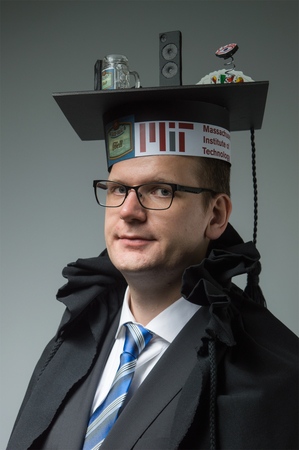Martin Kraus
Motion Correction and Signal Enhancement in Optical Coherence Tomography
Abstract
Optical Coherence Tomography (OCT) is a non-invasive optical imaging modality with micron scale resolution and the ability to generate 2D and 3D images of the human retina. OCT has found widespread use in ophthalmology. However, motion artifacts induced by the scanning nature restrict the ability to have reliable quantification of OCT images. Furthermore, OCT suffers from speckle noise and signal quality issues.
This work addresses these issues by treating the motion correction problem as a special image registration problem. Two or more 3D-OCT volumes with orthogonal scan patterns are acquired. A custom objective function is used to register the input volumes. As opposed to standard image registration, there is no reference volume as all volumes are assumed to be distorted by motion artifacts. To improve the robustness of the correction algorithm, multi-stage and multi-resolution optimization, illuminationand tilt-correction and custom similarity measures and regularization are employed. After registration, the corrected volumes are merged and a single volume with less noise is constructed by adaptively combining the registered data.
A large-scale quantitative evaluation was performed using data acquired from 73 healthy and glaucomatous eyes. Three independent orthogonal volume pairs for each location of both the optic nerve head and the macula region were acquired. The results of two motion correction algorithm profiles were compared with performing no motion correction. The evaluation measured registration performance, reproducibility performance and signal improvement using mutual information, error maps based on the difference of automatic segmentation of retinal features and a no-reference image quality assessment. In all three of these aspects, the proposed algorithm leads to major improvements, in accordance with visual inspection. For example, the mean blood vessel map reproducibility error over all data is reduced to 47% of the uncorrected error.
The algorithm has been deployed to multiple clinical sites so far. In addition, the technique has been commercialized. The main application is structural imaging for clinical practice and research. The removal of motion artifacts enables high quality en face visualization of features. The technique has also been applied to hand held OCT imaging and small animal imaging. Furthermore, applications in functional imaging in the form of intensity based angiography and Doppler OCT have been demonstrated.
Overall, the motion correction algorithm can improve both the visual appearance and the reliability of quantitative measurements derived from 3D-OCT data substantially. This promises to improve diagnosis and tracking of retinal diseases using OCT data.
